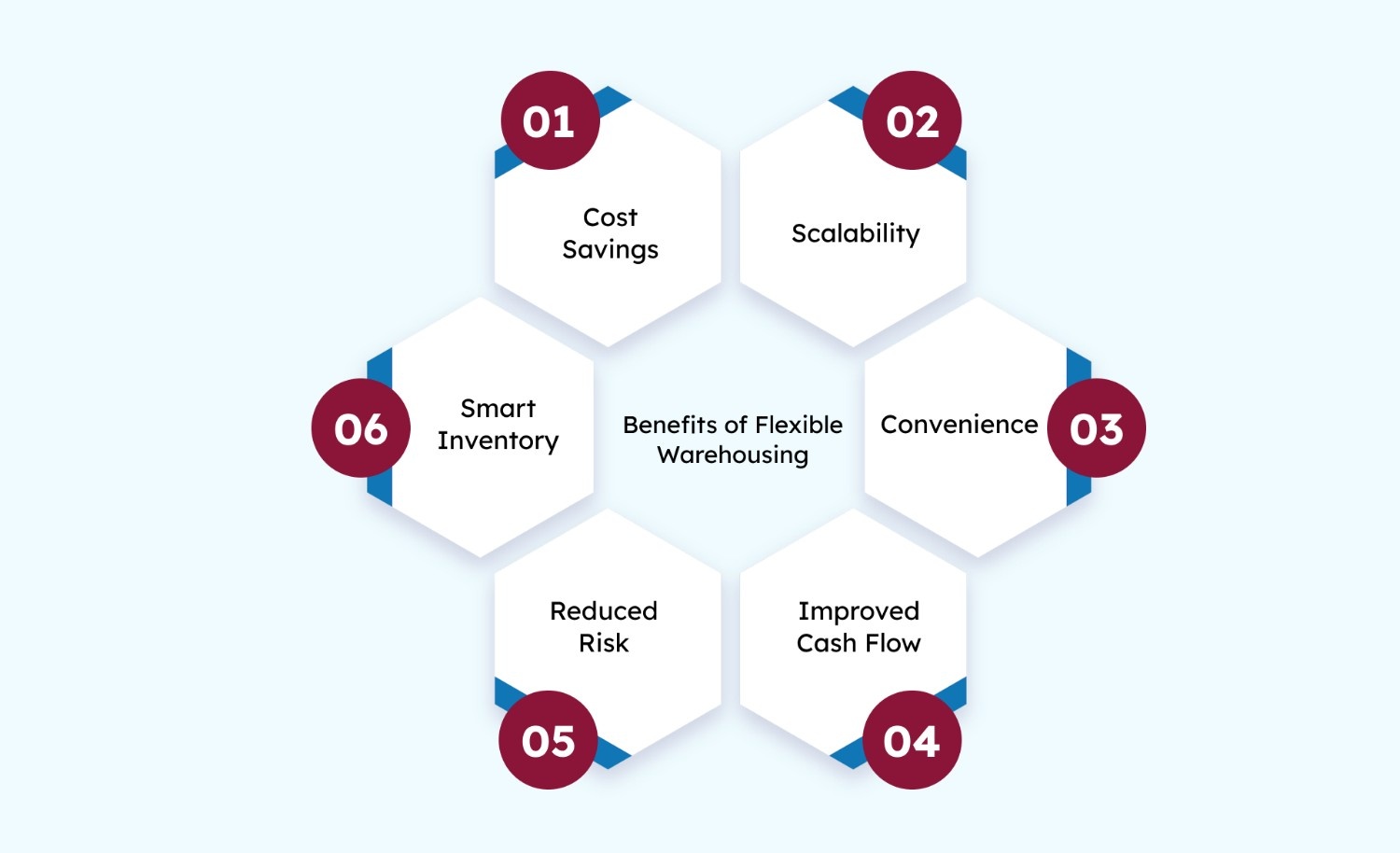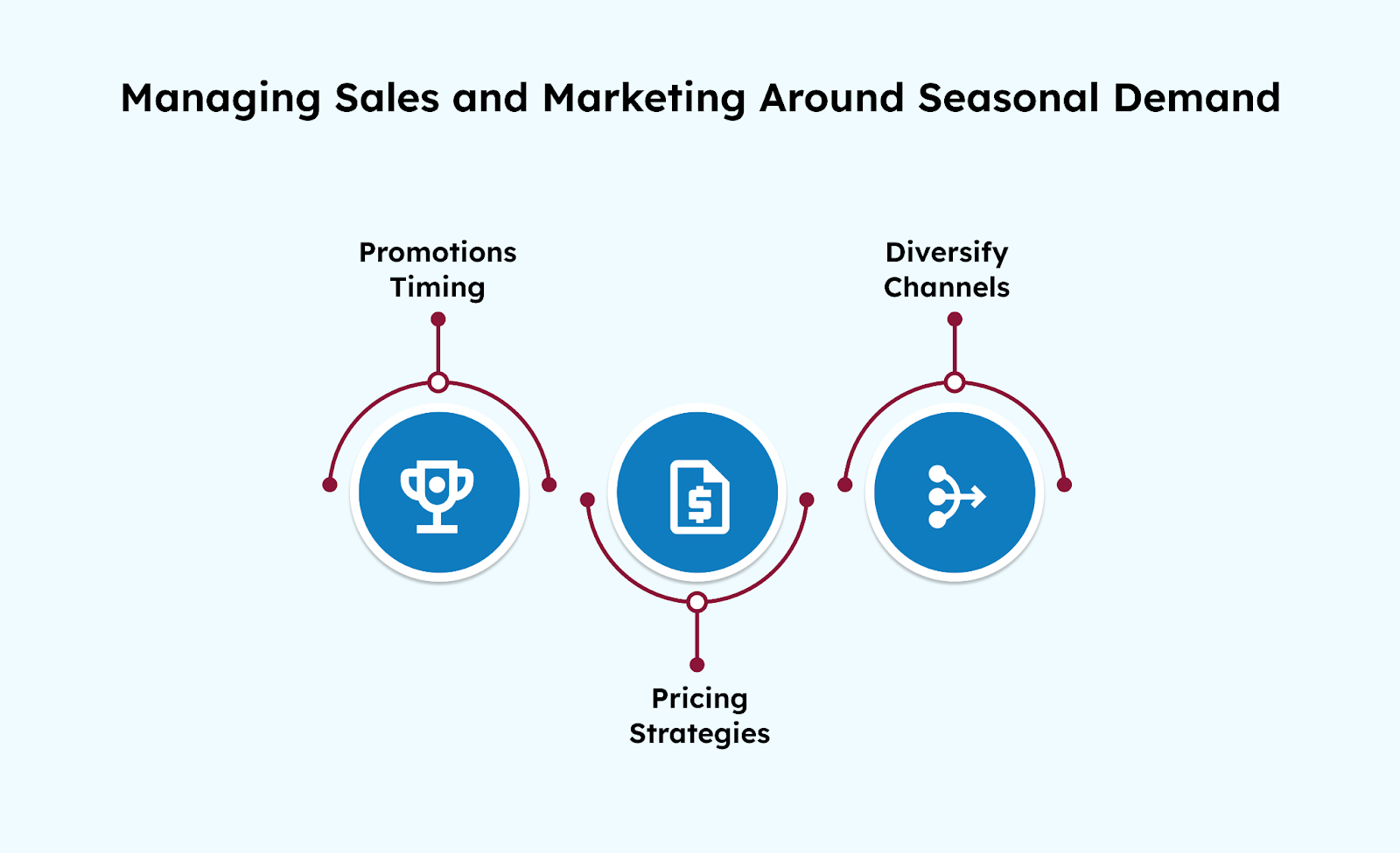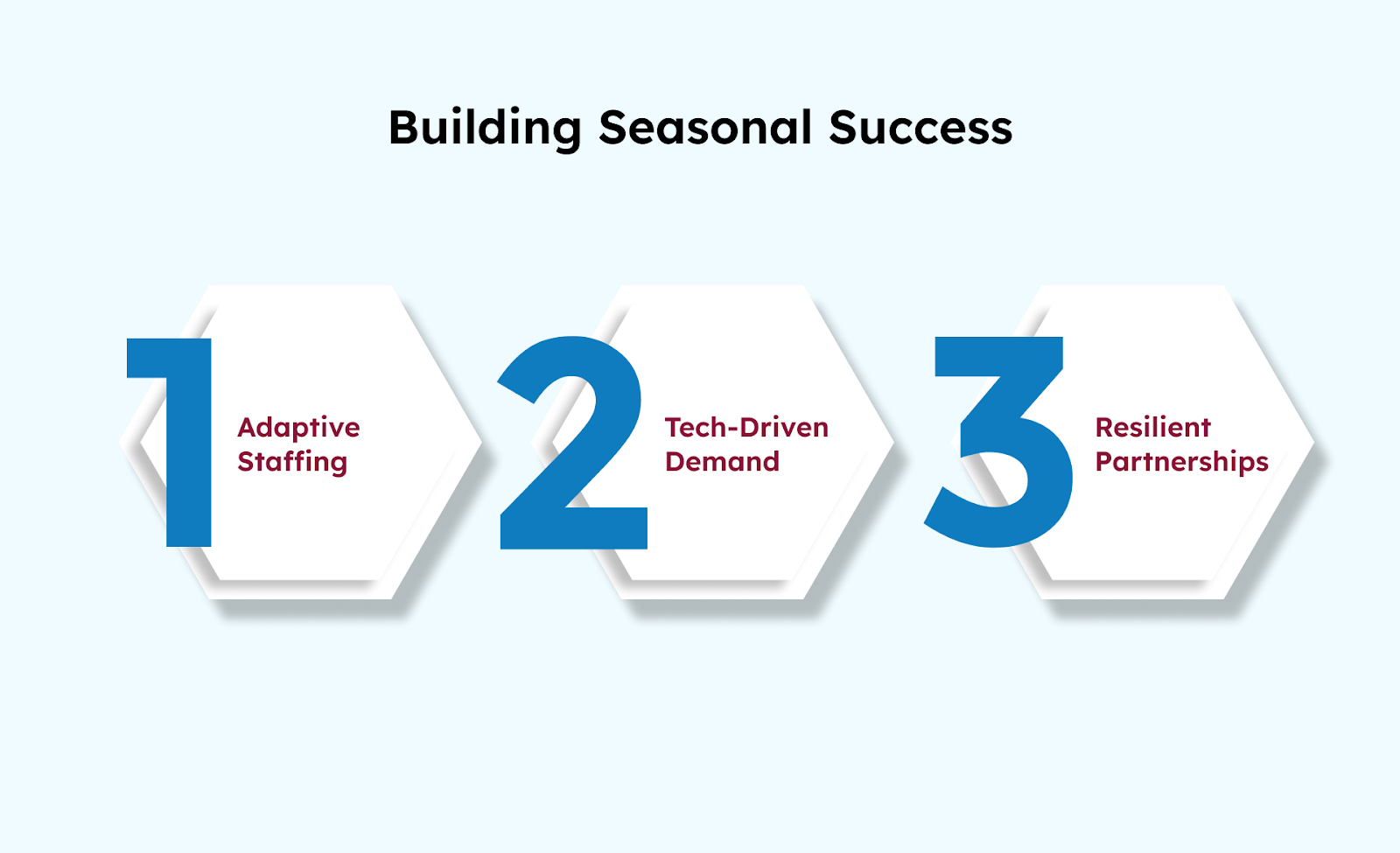Managing seasonal demand remains a major challenge for businesses. According to a study by IHL Group, in 2023, the global cost of inventory distortion, including overstocks and out-of-stocks, was reported to reach $1.77 trillion, with overstocks alone accounting for $562 billion. This highlights the urgent need for smarter, more flexible strategies to handle seasonal fluctuations effectively.
Seasonal spikes during holidays, festivals, or peak periods can strain inventory, warehouse space, and logistics. Without smart forecasting and flexible supply chain strategies, businesses risk stockouts, delays, and unhappy customers.
In this blog, we'll share practical tips to help you manage seasonal demand smoothly and keep your operations flexible through every peak and slowdown.
What is Seasonal Demand?
Seasonal demand refers to predictable changes in customer purchasing patterns that occur at specific times of the year. These shifts are often linked to factors such as holidays, weather, cultural events, or industry-specific cycles.
Here are a few scenarios where seasonal demand can be experienced:
- Retail: The holiday season, especially around Christmas, Black Friday, and back-to-school, often drives a sharp increase in sales volumes.
- Apparel: Clothing retailers experience peaks aligned with seasonal changes, such as winter coats in autumn or swimwear in spring. The fashion industry often plans new collections around these demand cycles.
- Agriculture and Food: Seasonal harvesting creates natural supply and demand cycles, requiring precise timing in supply chain operations.
- Travel and Tourism: Demand spikes during school holidays, summer vacations, or special festivals can stress booking systems and customer service.
Ultimately, understanding seasonal demand is crucial for businesses to effectively manage their inventory, optimise staffing, and plan marketing strategies throughout the year. This is particularly vital for e-commerce and small retailers, where predictable spikes in sales during events like Ramadan and Eid in the GCC can significantly impact both sales and operational efficiency.
Why Managing Seasonal Demand Matters?
Season demand impacts various parts of your business operations, including inventory management and logistics. These changes can create challenges across the board.
Here are the main areas affected by seasonal demand:
- Inventory Balance: Without accurate demand forecasting, you risk overstocking or understocking, which can result in lost sales and dissatisfied customers.
- Warehouse Utilisation: Your storage needs can balloon during peak times and shrink after. Traditional long-term warehouse leases often fail to offer the necessary flexibility for this purpose.
- Supply Chain Stress: Increased order volumes require more transportation, packaging, and handling resources. Without proper coordination, this leads to delays and increased costs.
- Workforce Management: Seasonal peaks often necessitate additional staffing or overtime, which can lead to increased labour costs and complicated scheduling.
Understanding these impacts is the first step toward building a supply chain that can adapt smoothly to seasonal fluctuations. The foundation of this adaptability lies in accurate demand forecasting, which we'll explore next as the cornerstone of effective preparation.
Forecasting Demand: The Cornerstone of Preparation
One of the most important steps in managing seasonal demand is having an accurate forecast. Forecasting demand means predicting how much product your customers will want during different times of the year. Getting this right can save you from costly mistakes, such as overstocking or running out of popular items.
How to Build a Reliable Forecast?
Start by looking at your historical sales data. Check when demand was highest in previous years and how big the spikes were. Identify which products sold well during those peak periods. This information gives you a solid foundation.
Next, consider the following factors that can influence demand:
- Upcoming promotions or marketing campaigns that might increase sales.
- Market trends and changes in customer preferences.
- External influences, like economic shifts or seasonal events.
Many businesses now use AI and data analytics tools to improve forecasting. Platforms like Microsoft Power BI, Tableau, and specialised tools such as Forecast Pro use machine learning to analyse data and spot patterns that manual methods might miss. These tools can also detect unexpected changes early, giving you more time to adjust your plans.
By combining data and technology, you can make smarter supply chain decisions. With accurate forecasts in hand, flexible warehousing lets you easily adjust storage space to match your seasonal demand.
Flexible Warehousing: Scale Up and Down as Needed
Finding the right amount of warehouse space during seasonal peaks is a major challenge for many businesses. Paying for large, long-term leases can become costly when demand drops, leaving you with unused space and wasted expenses. This is where flexible, on-demand warehousing offers a powerful solution.
Key Benefits of Flexible Warehousing

Flexible warehousing provides businesses with a more adaptable and cost-effective way to manage their storage needs. Here are the key benefits that can help your business thrive:
- Cost Savings: Avoid expensive long-term leases and pay only for the space you actually use.
- Scalability: Easily increase or reduce your storage capacity to match seasonal demand fluctuations.
- Convenience: Quickly search, book, and manage warehouse space online without complicated contracts.
- Improved Cash Flow: By minimising fixed costs, you free up capital to invest in other areas of your business.
- Reduced Risk: Avoid being locked into contracts that don't align with your evolving needs.
- Better Inventory Management: Align your storage capacity with accurate demand forecasts for efficient stock control.
With flexible warehousing, you can keep operations lean and ready for seasonal demand.
WareOne helps by offering short-term warehouse rentals with no long-term contracts, letting you book exactly the space you need quickly and affordably.
But having the right space is only part of the equation. Effectively managing your inventory during these seasonal shifts is equally important to keep your supply chain running smoothly.
Inventory Management Techniques That Work
Efficient inventory management is essential for handling season demand smoothly. Without the right strategies, businesses risk tying up capital in excess stock or facing lost sales due to shortages. The key is to balance stock levels, so you have enough product to meet demand without overstocking.
Key Inventory Strategies for Seasonal Demand
Several proven inventory techniques help businesses manage stock effectively during peak periods:
- FIFO (First In, First Out): This method ensures that older inventory is sold before newer stock, prioritising the oldest items first. It's especially critical for perishable goods or products with expiration dates, as it reduces waste and spoilage.
- JIT (Just-In-Time): JIT minimises holding costs by synchronising inventory arrivals closely with production or sales schedules. This approach reduces storage time and frees up cash flow, but requires reliable suppliers and precise forecasting.
- Safety Stock: Maintaining a buffer of extra stock helps protect against unexpected demand spikes or supply chain delays. The size of your safety stock depends on your industry, supplier reliability, and the predictability of your demand.
No single technique works alone. Businesses combine these methods with accurate forecasting and real-time tracking to maintain optimal stock levels, preventing stockouts and overstocking during busy seasons.
Managing inventory helps, but to handle seasonal peaks well, you also need to improve your whole supply chain.
Improving Your Supply Chain for Seasonal Peaks
Season demand adds significant pressure to your entire supply chain, making early and frequent coordination with suppliers and logistics partners essential. By working closely together, you can better prepare for fluctuations and maintain smooth operations.
Here are some key ways to streamline your supply chain during peak periods:
- Collaborate Closely: Share your seasonal forecasts with vendors and carriers to ensure they're prepared.
- Flexible Transportation: Use on-demand transport to match capacity and cut costs. For small shipments, shared LCL shipping adds flexibility.
- Track in Real-Time: Use technology that provides visibility into your shipments, inventory, and orders so you can act fast if issues arise.
- Build Contingency Plans: Prepare backup suppliers and alternative routes to quickly respond to unexpected disruptions during peak seasons.
Keeping communication open and using flexible logistics services helps your business stay ahead of bottlenecks during peak periods. At the same time, aligning your sales and marketing efforts with seasonal demand helps smooth out spikes and ensures that your supply chain can keep pace with customer needs.
Managing Sales and Marketing Around Seasonal Demand

Beyond operations, managing seasonal demand also requires effective sales and marketing tactics to mitigate spikes and boost revenue. By carefully planning your promotions and pricing, you can influence customer buying patterns and create a steadier flow.
Here are some effective strategies to consider:
- Promotions Timing: Start marketing campaigns early to spread demand over a longer period, reducing last-minute rushes.
- Pricing Strategies: Use dynamic pricing or early-bird discounts to encourage pre-orders and balance demand.
- Diversify Channels: Explore new sales channels like online marketplaces, pop-up stores, or social commerce to reach customers wherever they shop.
These approaches help flatten the demand curve, making it easier to manage supply and fulfill orders efficiently. Alongside adjusting sales and marketing, it's equally important to ensure your workforce can adapt to these changing demands.
Building Seasonal Success: Workforce, Tech & Partners

Effectively managing season demand requires a comprehensive approach that includes adapting your workforce, using technology, and strengthening partnerships. These elements work together to create a supply chain that can quickly adjust to fluctuations, minimising disruptions and maintaining service quality.
Let's break down how each of these areas contributes to a stronger, more responsive operation.
1. Flexible Staffing to Handle Changing Workloads
Seasonal peaks mean your staffing needs will vary. Preparing ahead ensures you have the right people in place when demand rises:
- Hire Temporary or Seasonal Workers: Quickly scale your workforce during busy periods without long-term commitments.
- Cross-Train Employees: Equip your team to perform multiple roles, allowing you to shift resources as needed.
- Advance Planning: Schedule recruitment and training before peak seasons to avoid last-minute rushes and maintain service standards.
By making staffing flexible, you can meet demand efficiently while controlling labour costs during slower periods.
2. Use of Technology for Smarter Demand Management
Technology gives you the tools to anticipate and respond to demand changes with precision:
- AI-Powered Forecasting: Analyses diverse data sources to provide more accurate predictions. For example, IBM Watson Analytics is widely used for this.
- Real-Time Inventory and Order Tracking: Offers instant visibility into stock levels and order progress. NetSuite is a popular platform for this.
- Automated Alerts: Quickly notify managers of potential shortages or shipment delays for faster response. Odoo can be used to set up such alerts.
WareOne's platform combines real-time tracking with AI-driven warehouse matching, helping businesses optimise storage and logistics on the go.
3. Strengthening Partnerships to Build Supply Chain Resilience
Close collaboration with your suppliers and partners helps smooth out seasonal challenges:
- Flexible Vendor Agreements: Work with suppliers who can adjust order volumes and delivery schedules as needed.
- Regular Communication and Data Sharing: Keep everyone aligned by exchanging forecasts and sales trends frequently.
- Collaborative Problem-Solving: Address disruptions like delays or capacity issues together, ensuring quicker resolutions.
Partnering with the right fulfillment provider is crucial during seasonal peaks. To find the best fit for your business, check out our detailed guide on Choosing the Right Fulfillment Partner for Your Business.
By combining flexible staffing, smart technology, and strong partnerships, your business can handle seasonal demand with greater confidence and efficiency. This integrated approach not only minimises disruptions but also positions your operations for sustained growth throughout the year.
How WareOne Supports Your Seasonal Demand Challenges
Managing seasonal demand requires a logistics partner that offers flexibility, transparency, and scale. WareOne helps your business stay agile and efficient by providing the following solutions:
- Flexible On-Demand Warehousing: Increase or decrease storage space without long-term contracts or upfront costs. Pay only for the space you use, ideal for peak and off-peak seasons.
- Strategic Warehouse Locations: Our warehouses, situated near major Qatari ports and transport hubs, enable faster deliveries during periods of high demand.
- Real-Time Inventory Visibility: Access end-to-end stock tracking via our cloud-based platform to avoid stockouts or overstocking.
- Integrated Transport and Last-Mile Delivery: Partnering with local carriers, we optimise last-mile delivery for quicker order fulfilment and improved customer satisfaction.
- Cross-Docking Capabilities: Minimise storage time by transferring inbound shipments directly to outbound carriers, speeding up distribution.
- Importer of Record (IOR) Services: For businesses entering Qatar, we handle customs clearance and compliance, ensuring faster product availability.
- Scalable Fulfilment Services: Customised warehousing, picking, packing, and shipping services to suit your seasonal needs, whether you're an e-commerce brand or a large enterprise.
- Transparent Pricing and No Hidden Fees: Control your logistics budget with clear, pay-as-you-use invoicing and no surprise charges.
- Data-Driven Optimisation: Utilise analytics to evaluate performance and plan effectively for future peaks.
Unlike traditional providers, WareOne's digital platform enables instant booking and scalability, ensuring you can quickly secure the space you need during sudden seasonal spikes. By choosing WareOne, you gain a responsive and cost-efficient logistics partner to manage demand fluctuations throughout the year.
Conclusion
Seasonal demand challenges are a natural part of running a business across many industries. The real advantage comes from embracing flexibility, using accurate data, and building strong partnerships to stay ahead. When you forecast demand precisely, you can plan more effectively and avoid costly surprises.
Combining scalable warehousing and logistics solutions, such as WareOne, with clear and open communication throughout your supply chain creates a resilient operation. This approach enables you to consistently meet customer expectations while keeping costs under control, regardless of fluctuating demand throughout the year.
Take control of your seasonal demand with WareOne's digital warehousing marketplace and on-demand logistics. Pay only for the space and services you need, exactly when you need them. Find flexible warehouse space and scalable logistics tailored to your business. Contact us today to learn more.
FAQs
1. What is seasonal demand?
Seasonal demand refers to fluctuations in customer demand that occur at specific times of the year, such as holidays, festivals, or weather-related seasons. These predictable changes impact sales, inventory, and supply chain operations.
2. Why is managing seasonal demand important?
Properly managing seasonal demand helps businesses avoid stockouts and overstocking, reduce costs, and maintain customer satisfaction during peak and slow periods.
3. How can I forecast seasonal demand accurately?
Accurate forecasting involves analysing historical sales data, market trends, and external factors. Using AI-powered forecasting tools can improve prediction accuracy by processing large datasets and spotting patterns.
4. What inventory management techniques work best for seasonal demand?
Popular methods include FIFO (First In, First Out) to manage product turnover, JIT (Just-In-Time) to minimise holding costs, and maintaining safety stock as a buffer against demand spikes or delays.
5. How does flexible warehousing help with seasonal demand?
Flexible warehousing enables businesses to rent storage space on demand, scaling up during busy seasons and down during slower periods, thereby reducing costs and increasing operational agility.
.jpg)